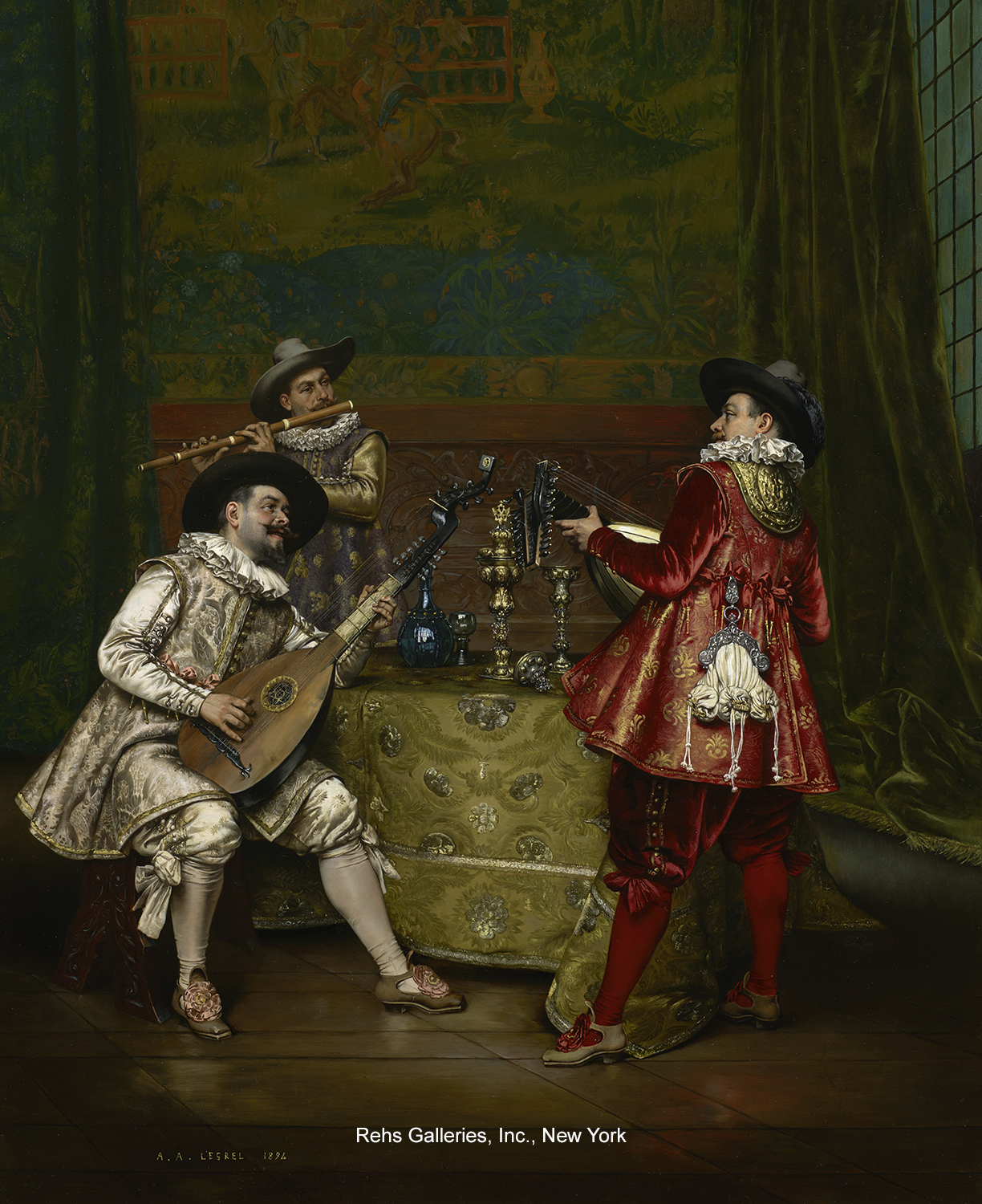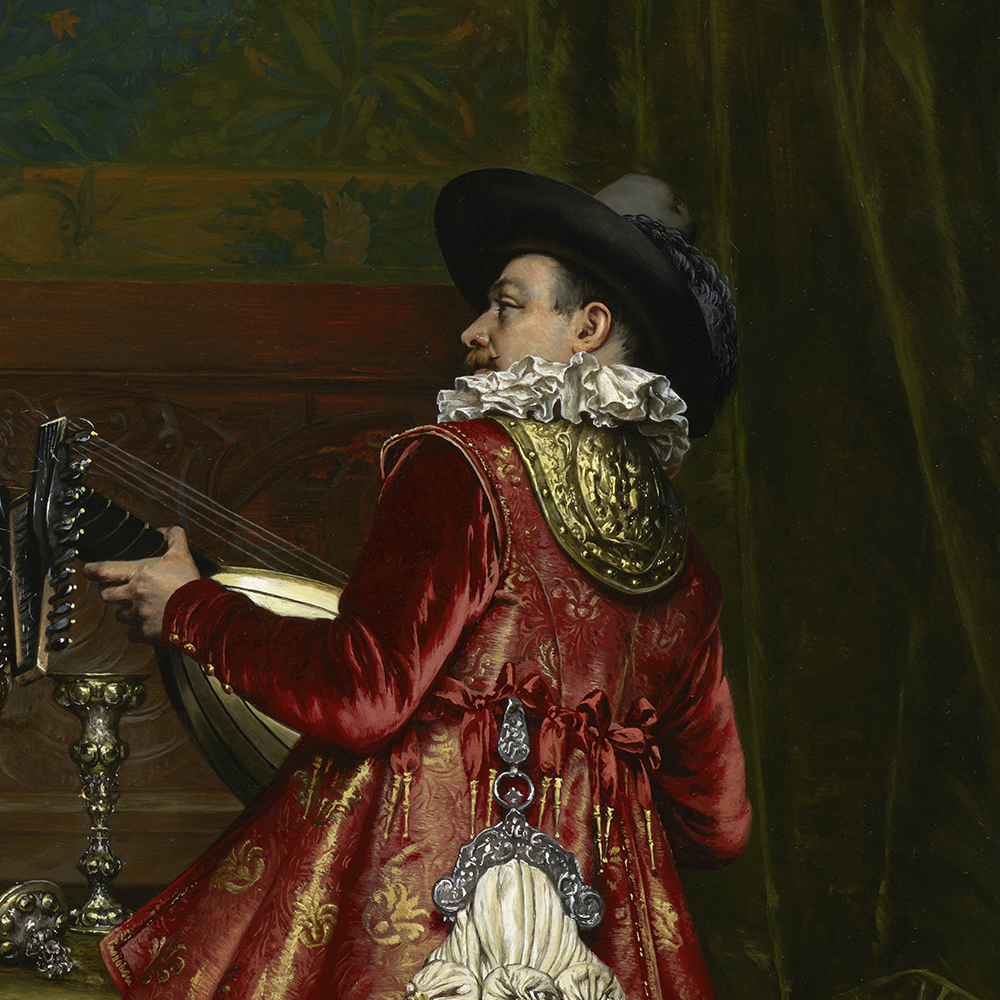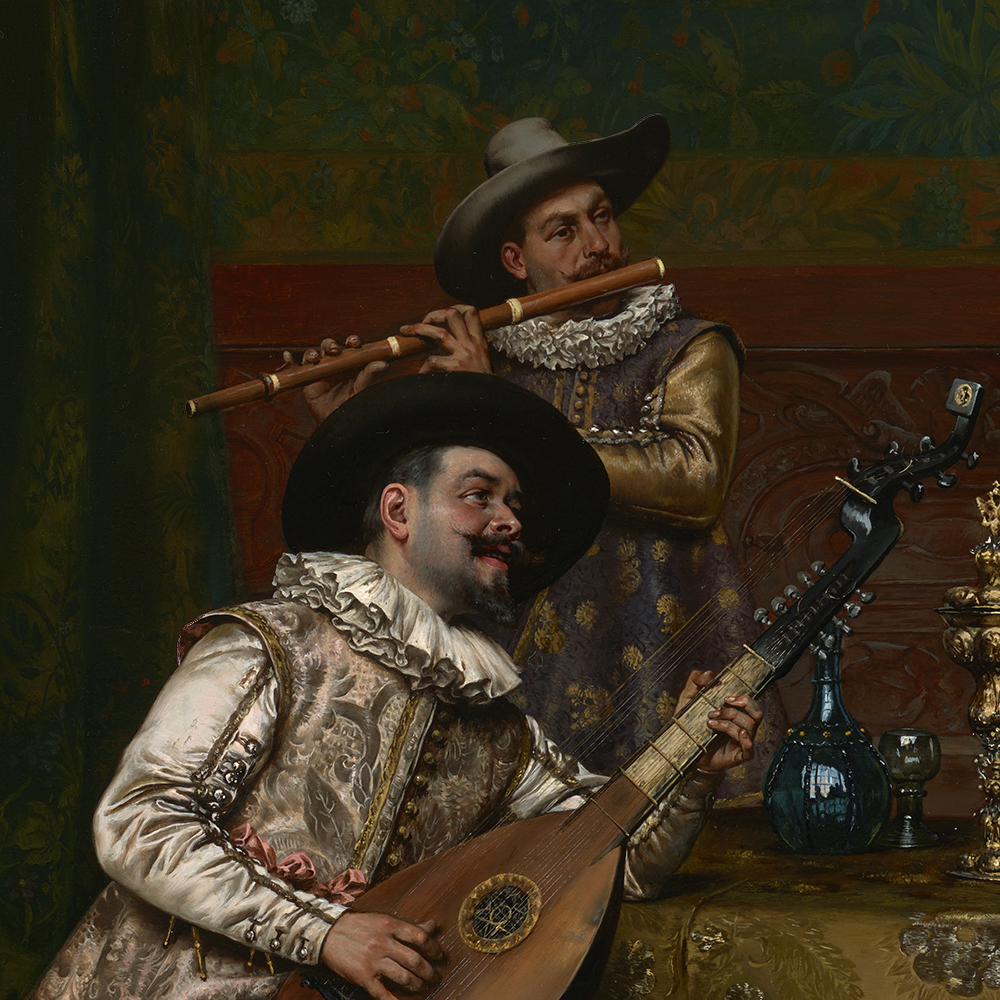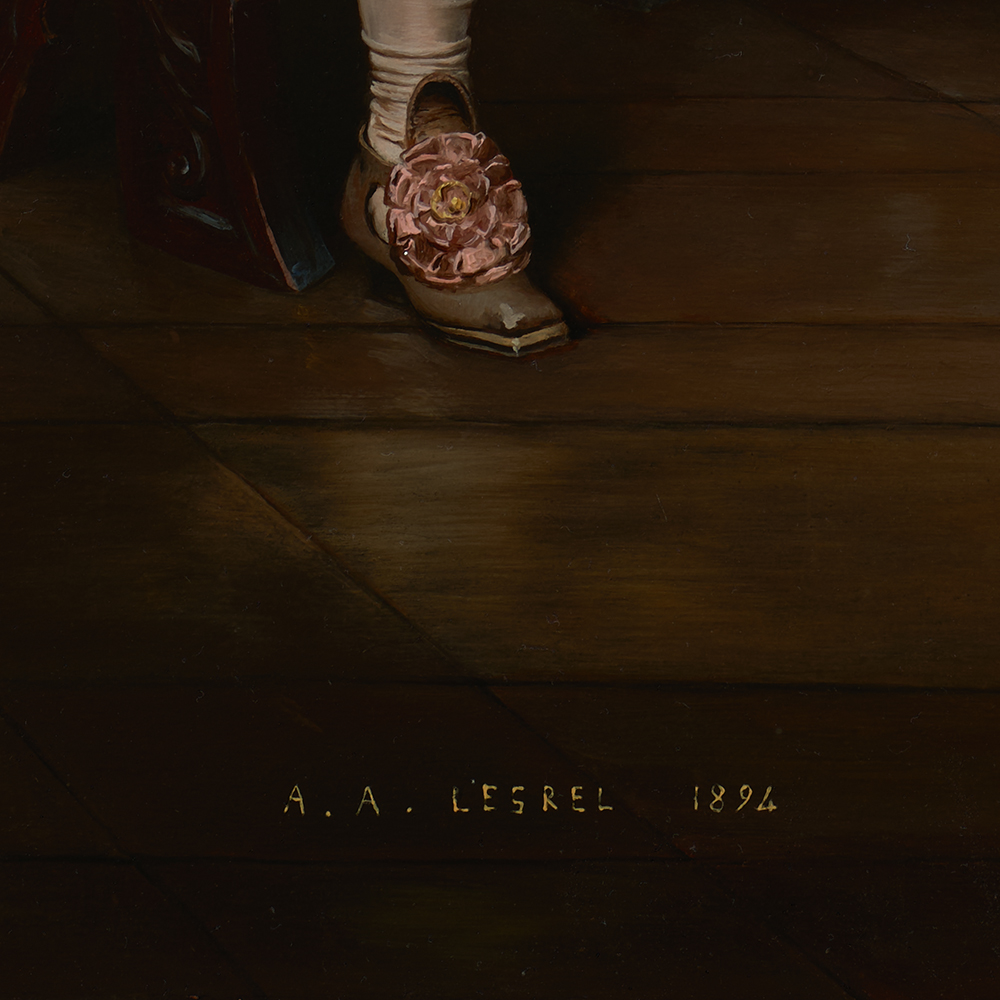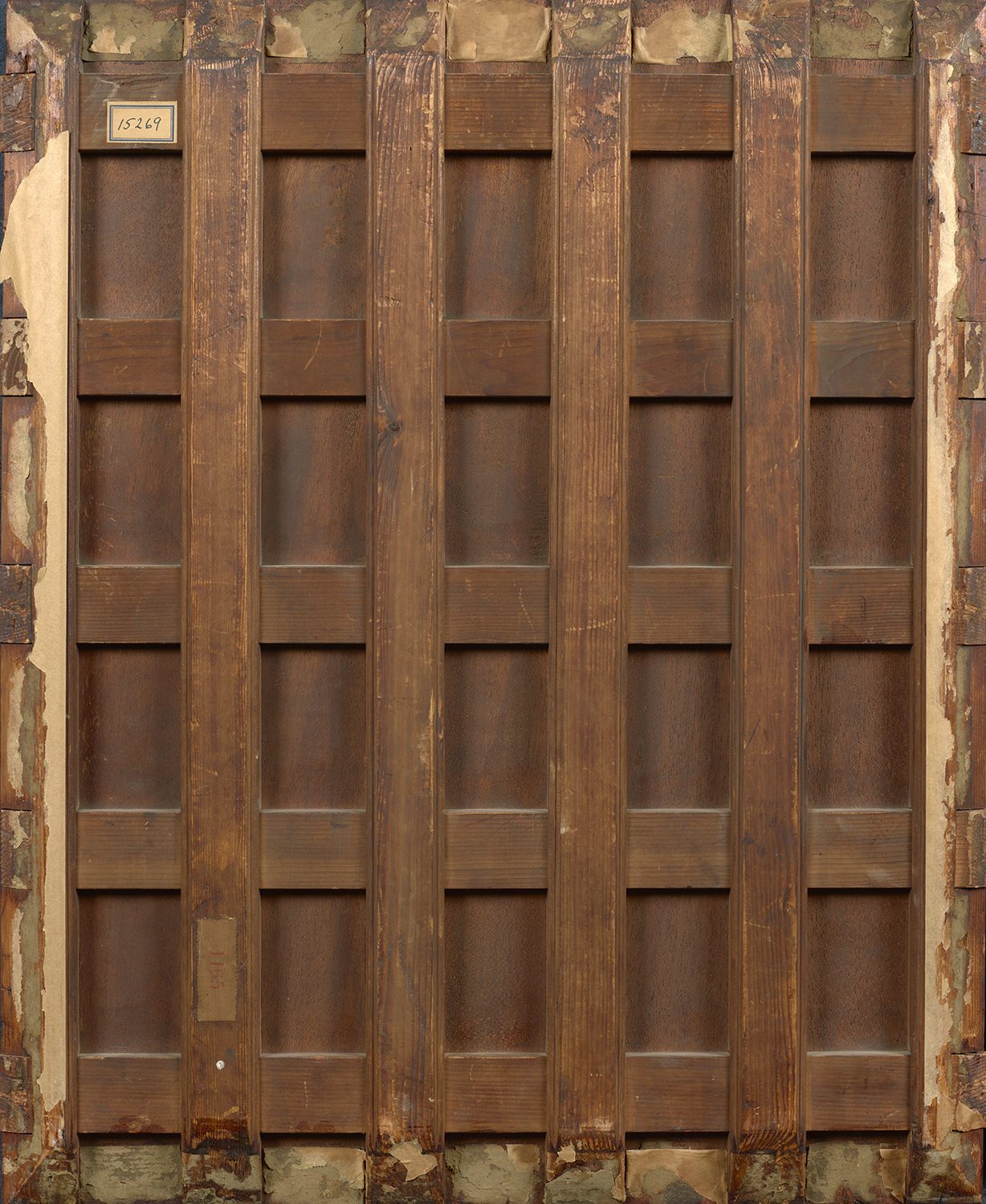Adolphe Alexandre Lesrel
(1839 - 1929)
Un trio
Oil on panel
22.875 x 18.625 inches
Framed dimensions:
28 625 x 24.375 inches
Signed and dated 1894
BIOGRAPHY - Adolphe Alexandre Lesrel (1839 - 1929)
Born on May 19, 1839 in the small community of Genêts, France on the English Channel, Adolphe Alexandre Lesrel grew up within sight of Mont-St.-Michel, that mysterious abbey constructed in 708 when the archangel Michael reportedly appeared to Bishop Aubert of Avranches, and instructed him to build a church on the isolated rocky island. Although it is accessible only at low tide, Mont-St.-Michel captured the mystical sensibility of the early medieval imagination, and has remained an enigmatic and sacred site for artists and pilgrims ever since. In the second half of the nineteenth century, the allure of Mont-St.-Michel was a frequent subject for painters and poets such as Stéphane Mallarmé and William Butler Yeats as well as the innovative musical compositions of Claude Debussy and Maurice Ravel.
For an imaginative young boy living close to the beaches of the region, Mont-St.-Michel would have been a constant presence, perhaps inspiring tales of adventurous exploits and escapades. As the son of middle-class landowners in Genêts, Lesrel was raised in comfortable circumstances, but he seems to have dreamed of an artistic career from an early age. With that goal in mind, he left his small village in 1861 to study at the Ecole des Beaux-Arts in Paris.
Lesrel was twenty-two when he began his studies with the academic painter, Jean-Léon Gérôme (1824-1904). Like many aspiring painters, he hoped to follow in Gérôme’s footsteps as a history painter of scenes from ancient Greece and Rome. By 1861, however, Gérôme had already begun to expand his repertoire to include exotic scenes from Egypt and North Africa as well as genre scenes based on French historical eras. For the young Lesrel, the scope of work that his professor was exploring encouraged him to consider a broader range of subjects as well. In particular, Lesrel was fascinated with the work of an-Louis Ernest Meissonier (1815-1891), whose meticulous, detailed historical subjects were beginning to redefine history painting as a form of documentary art. At the Exposition Universelle in 1867, Meissonier exhibited no less than fourteen paintings, an extremely successful venture and one that must have impressed Lesrel deeply.
After several years of study with Gérôme, and later with Meissonier, Lesrel made his Salon debut in 1865, launching a career that would bring him recognition and economic security for many years. In the late 1860s and 1870s, his painting was largely based on a romanticized vision of the Middle Ages, perhaps inspired by the work of the Pre-Raphaelite Brotherhood in England, or even the Nazarene painters; both groups emerged on the European artistic stage in the 1840s and 1850s and would likely have been known to the arts community in Paris. Lesrel’s 1873 painting, Flirtation in the Town Square, clearly suggests the influence of the Pre-Raphaelite Brotherhood in its use of a medieval architectural setting, detailed and richly textured costumes and the subject of a romantic encounter between a red-haired young woman and a dashing young troubadour. In terms of technique, the careful attention to detail also demonstrates the importance of Meissonier’s influence.
The painting may also have reflected the artist’s private life at this time. In 1872, he married Joséphine Létang, who had been one of his models. The newlyweds set up housekeeping in Paris and eventually had two daughters, Marthe-Thérèse and Jeanne, both of whom occasionally posed for their father’s paintings.
By the 1880s, Lesrel’s canvases grew increasingly sophisticated and his subject matter expanded to incorporate lightly erotic images. The Drunken Bacchante from 1882, for example, owes a debt to the tradition of academic female nudes in the style of Alexandre Cabanel or William Bouguereau; here, Lesrel references a classical bacchante, whose languid inebriation was to be expected, while simultaneously presenting the viewer with a luscious nude woman fully displaying her charms. By cloaking the titillating image in the trappings of classical Greece, the artist allows his clients to similarly mask the nature of their interest in the subject. Perhaps more significant is Lesrel’s notably confident and relaxed mastery of his medium.
Throughout his career, Lesrel exhibited one or two paintings at the annual Salon, and in 1885, he became a member of the Société des Artistes Française. His work was recognized with an honorable mention at the 1889 Exposition Universelle, the resplendent world fair for which the Eiffel Tower was designed. A year later, in 1890, he joined the Société Nationale des Beaux-Arts, then under the direction of Meissonier who served as president of the organization until his death in 1891.
At some point in the 1880s, Lesrel began to focus his attention more specifically on historic genre paintings dealing primarily with scenes from the time of king Louis XIII (1601-1643). Unlike his earlier medievalizing canvases, Lesrel was now showcasing scenes of sophisticated gentlemen engaged in activities related to intellectual pursuits such as art collecting, architectural design, chess games, musical parties and the consumption of fine wines. There are very few women in these paintings, and the setting is almost always a domestic interior of some sort. Although these paintings might trace their lineage back to the troubadour paintings of the first half of the nineteenth century, they are less about romanticizing the gothic and renaissance past, and more about evoking the 17th century when France was emerging as an important European power.
The reign of Louis XIII was characterized by a transition from the chaotic period during his mother’s seven-year regency after the assassination of her husband, Henri IV, to a more sophisticated and stable era when the king himself was in charge. He was a successful political leader who contained the Hapsburg empire during the Thirty Years War (1618-1648), and quelled a rebellion by the French nobility, in addition to instituting a policy of peaceful cooperation with the Native American people of New France. By the mid-nineteenth century, Louis XIII’s reputation as a warrior, diplomat and ruler had transformed him into the fictional sovereign described by Alexandre Dumas in The Three Musketeers. (The Three Musketeers was originally published as a serialized novel in Le Siècle, March-July 1844.) By the 1880s, Louis XIII had become a figure of irreverent humor at the Montmartre cabaret, Le Chat Noir, where supposedly “Louis XIII” furniture became part of satirical commentary. In short, by the time that Lesrel began painting his scenes of courtly gentlemen, the evocation of the age of Louis XIII was a familiar feature of popular culture.
Lesrel’s paintings suggest not the “musketeer” image so much as that of dashing, urbane men who are well educated, culturally sophisticated and impeccably dressed. Although there is often an understated humor in these canvases, they seem to have appealed to art collectors who saw themselves as the contemporary equivalent of the seventeenth century figures in the paintings. Lesrel’s work found a welcoming audience in both London and the United States beginning in the 1880s. His work was frequently listed in the auction catalogues of the American Art Galleries in New York as well as at Arthur Tooth and Sons gallery in London. [i]
Although the extent of Lesrel’s work with Goupil and Company is not fully documented, it is known that at least some of his paintings were reproduced as etchings and promoted through Goupil’s extensive distribution system. One painting in particular, titled Flemish Nobles Visiting the Studio of Rembrandt, was a resounding success in Philadelphia where it was included in several publications. [ii]
With his career well established, Lesrel left Paris in 1907 and moved back to his home town of Genêts. He was then sixty-eight years old, and perhaps was simply hoping to retire to a quieter life by the sea. There he created a painting for the town hall entitled Le Chevalier blanc and designed a stained glass window for the local Church of Notre Dame as well. This peaceful life was disrupted seven years later by the declaration of war in 1914. Although Genêts is located to the west of the main battlegrounds in northeastern France and Belgium, it must have been a very uneasy period, especially for a man then in his seventies.
Although information about his later years is scant, Lesrel survived the horror of World War I, and continued to live at Genêts until his death on February 25, 1929; just two months shy of his ninetieth birthday.
Janet Whitmore, Ph.D.
Selected Museums
Baltimore Museum of Art
Bury Art Museum & Sculpture Centre, Bury, Lancashire, UK
Figge Art Museum, Davenport, Iowa
Musée des Beaux-Arts, Nantes, France
Musée des Beaux-Arts, Rouen, France
Musée des Beaux-Arts, Saint-Lô, France
Musée d'Art et d'Histoire, Avranches, France
New York Public Library
Syracuse University Art Gallery, Syracuse, New York
[i] American auction catalogues and publications including Lesrel’s paintings include a variety of art galleries and publishers. See Private Collection of Modern Paintings belonging to Mr. Walter Bowne of Flushing, Long Island. Auction by American Art Galleries, New York March 5, 1890; American Art Annual, vol. III, Florence N. Levy, editor (Boston: Noyes, Platt & Company, 1900) 36; Catalogue of Valuable Paintings Collected by the Late F. O. Matthiessen (New York: American Art Galleries Auction catalogue,1902); American Art Annual, vol. XI, Florence N. Levy, editor (New York: American Federation of Arts, 1913) 444; and American Art Annual, vol. XIV Florence N. Levy, editor (New York: American Federation of Arts,1917) 372.
[ii] See Armand Silvestre, The Gallery of Contemporary Art: An Illustrated Review of the the Recent Art Productions of all Nations, Volume 2 (Philadelphia: Gebbie & Co., Publishers, 1885). The same etching was again published in Daniel B. Shepp, Shepp's Library of History and Art: A Pictorial History of All Lands and Times (Philadelphia: Globe Bible Publishing Company, 1905) 190.

